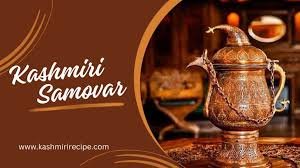Kashmiri Samovar (Tradition tea kettle) is an important symbol of Kashmiri culture, which has a centuries old history. “Samovar” is actually a Russian word, which means “self-heating.”
Great Sufi saint Hazrat Shah Hamdan introduced Samovar here which reached Kashmir through Russia, Persia and Turkey. The great Sufi saint along with preaching and preaching in Kashmir introduced many arts and crafts, including the art of making samovar.
Samovar is found in almost every house of Kashmir. It is made of copper or brass. Inside the samovar, a metal tube passes through the middle, which acts as a separate chamber for the chimney and burning coal.
The chimney has small holes at the bottom so that the smoke can escape and collect at the bottom, which is later cleaned. For carrying samovar from one place to another, a handle is provided.
Locally called as “Hee” is the nose-shaped spout from which the tea comes out. On top of this spout, a small lid is placed which is called “Zayo” in Kashmiri. The main body of the samovar is connected to the lower part by a “neck”.
Called as “Kasagars”, the samovar makers are found in both villages and cities. The Zaina Kadal area of Srinagar is its main market. The samovar is safe for use in homes and is rust-free. The “Qalai” applied on it gives it a unique shine. These samovar makers are called “Qalaigar” in Kashmiri.





















